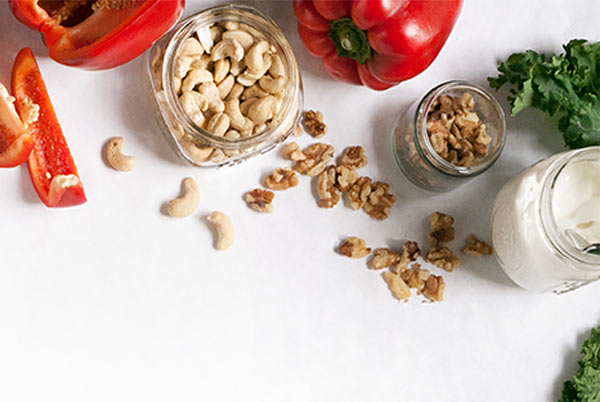
The Low FODMAP Diet
 Got Irritable Bowel Syndrome (IBS)? You’re definitely in good company. Twenty percent of Americans have it, and for many it’s a lifelong struggle. Some try out a wide range of diet therapies – gluten-free, high fiber, low fiber, Specific Carbohydrate Diet (SCD), probiotic-rich, and many others – and often they still suffer from discomfort.
Got Irritable Bowel Syndrome (IBS)? You’re definitely in good company. Twenty percent of Americans have it, and for many it’s a lifelong struggle. Some try out a wide range of diet therapies – gluten-free, high fiber, low fiber, Specific Carbohydrate Diet (SCD), probiotic-rich, and many others – and often they still suffer from discomfort.
Fortunately, there’s a new kid in town: the low FODMAP diet.
What’s a FODMAP?
FODMAP is an acronym for Fermentable Oligosaccharides, Disaccharides, Monosaccharides, and Polyols. I know — that doesn’t clear up much! Basically, FODMAPs are specific kinds of carbohydrates that some people have difficulty digesting, particularly people with IBS or Inflammatory Bowel Disease (IBD). Rather than getting absorbed in the small intestine as they should be, these poorly digested carbs are passed along to the large intestine. There they are fermented by bacteria and may absorb an abnormal amount of water, which triggers all sorts of obnoxious gastrointestinal symptoms such as bloating, diarrhea, gas, constipation, cramping, and abdominal pain.
Who Benefits?
Although the concept of reducing FODMAPs was virtually unheard of a decade ago, research teams in Australia have proven the benefits of the diet. According to the studies, approximately three-quarters of people with IBS have an improvement or even a disappearance of symptoms on a low FODMAP diet.
Kate Scarlata, RD, LDN, author of A Complete Idiot’s Guide to Eating Well with IBS, says, “Most patients with underlying IBS symptoms of bloating and distention will experience significant improvement in these symptoms when they go on a low FODMAP diet. Because FODMAPs draw water into the intestine and easily ferment causing gas, they can contribute to bloating and diarrhea in those prone to diarrhea and in individuals with constipation or a sluggish bowel the water can become trapped along with gas making them feel bloated and experience a distended belly.”
Obviously, people with celiac disease and gluten-sensitivity are high on the list of people likely to be experiencing tummy troubles.
It’s important to understand that a low FODMAP diet isn’t a healthier or better diet. It’s just a way to manage diarrhea, constipation, gas, bloating, and/or abdominal pain. If you’re already strictly gluten-free and still experiencing discomfort, it’s definitely worth a look. However, if you’re experiencing other kinds of non-digestive problems or you’re already feeling pretty fantastic, there are no additional nutritional benefits. Most likely it would mean cutting out quite a few nutritious foods such as garlic, onions, apples, cabbage, beans, and mushrooms.
How Does It Work?
FODMAPs are found in a wide range of foods. Generally, the impact they have on digestion is cumulative. That’s why someone might eat something one day and feel just fine, and then eat a larger portion or a combination of several triggers the next week and feel miserable. Also, it’s a low FODMAP diet, not a no FODMAP diet. Many foods have some amount of FODMAPs, but generally they only become problematic when the quantity is large.
In order to determine if FODMAPs are a trigger, it’s necessary to do an elimination diet. The first step is to avoid all major sources of FODMAPs for 6-8 weeks. Then add foods back systematically to narrow down the types and quantities of food that are causing a problem. “An important point about the low FODMAP diet is that it’s not designed for the long-term. It’s a ‘learning diet’ to help an individual identify which FODMAPs may be triggering their symptoms. The goal is to add back some of the more tolerable FODMAP containing foods to allow for the most varied and nutritious diet—and this is very individual,” says Scarlata. Most people don’t need to stay on the strict elimination diet long-term.
The FODMAP Line Up
• Oligosaccharides
- Fructans: These are found in many of the stereotypical “gassy” vegetables like asparagus, broccoli, Brussels sprouts, cabbage, onions, garlic, and a variety of other veggies, too. Wheat and rye have fructans asdoes inulin fiber, which is a major ingredient in many “health foods” like high fiber bars and even probiotics. o Galactans: Beans! I’m sure you’re shocked to discover that beans cause gas production. Chickpeas, lentils, and soybeans are common culprits.
• Disaccharides
- Lactose: This is found in dairy products including milk, evaporated milk, ice cream, and soft cheeses such as ricotta and cottage cheese.
• Monosaccharides
- Fructose: Fruit such as apples, pears, peaches, mangos, dried fruits, and fruit juice are the major sources. Honey, agave nectar, and high fructose corn syrup (HFCS) are significant sources as well.
• Polyols
- Sugar alcohols: These are the sweeteners that end in –ol, like sorbitol, mannitol, xylitol, and maltitol, which are found in sugar-free or “no net carbs” candies, chocolate bars, gum, mints, and more.
- Some fruits (such as apricots, blackberries, cherries, dates, plums, and watermelon) and vegetables (like cauliflower, mushrooms, and pumpkin) also have polyols.
That’s a lot of food off the table. By now you may be wondering what’s left?
Well, the good news is that FODMAPs are fermentable carbs, so that means that all foods that are pure protein like eggs, chicken, fish, beef, pork, and other meats as well as fats and oils naturally have no FODMAPs.
It’s by no means easy to follow a low FODMAP diet, but it could just be the ticket to reducing or eliminating symptoms and getting on track to feeling your best.
FODMAP Friendly Options:
Partial list of allowed foods:
| Fruits
(½ cup portions only)
|
Bananas Blueberries Cantaloupe Honeydew Kiwi Oranges Pineapple Raspberries Strawberries |
| Veggies
(½ cup portions only)
|
Carrots Eggplant Green and red bell peppers Green beans Kale (cooked) Spinach Tomatoes Potatoes Sweet potatoes |
| Nuts and seeds
(2 tablespoons)
|
Almonds Hazelnuts Peanuts Pine nuts Pumpkin seeds Sesame seeds Sunflower seeds Walnuts |
| Dairy |
Milk, yogurt, cottage cheese and ice cream labeled “lactose-free”
Butter
Low-lactose cheeses
|
| Fats | All fats and oils are fine—but large quantities of fats can be an IBS trigger. Limit to 1 teaspoon per meal. |
| Grains
(½ cup portions only)
|
Amaranth Buckwheat Corn Millet Oatmeal Rice Quinoa Wild rice |
| Proteins | All kinds of meat, poultry, fish,eggs, etc. are allowed. |
Get support – honestly.
I know it’s really tempting to go at it alone. After all, many people figure out a gluten-free diet on their own. But there are a couple of quirks about the low FODMAP diet that make it extra wise to call in reinforcements:
- It doesn’t follow the typical rules of logic. For example, you can have butternut squash but not pumpkin. Peanuts are a “go,” cashews are a “no.” Scallion greens are fine, onions are out. Raspberries are allowed, blackberries aren’t. It’s definitely not an intuitive list.
- The lists change with evolving research, so you want to use the latest and greatest version. Many of the lists around the internet have older or inaccurate info, or they are incomplete. Even this list is a shortened one.
- The quantity of foods containing FODMAPs does matter and they need to be spaced throughout the day.
- FODMAPs are in foods, but they can be in medications, supplements, and probiotics, too. Yes, the very things you’re taking to make the IBS go away may be making it worse.
- While the diet is mostly gluten-free, small amounts of gluten are allowed, so even some FODMAP friendly lists may contain foods you can’t eat.
So this really isn’t a great diet to try out on your own. Scarlata suggests, “If you are going to make the effort to give the low FODMAP diet a try, why not make sure you are doing it properly with the guidance of a dietitian so that you can truly figure out if you are sensitive to FODMAPs or not?”
There is a list of nutrition professionals that are specially trained on teaching a low FODMAP diet at www.ibsfree.net so you can find nutrition professional locally. If there isn’t someone near you, many nutritionists, including me, consult over the phone or Skype.
There are a couple of terrific books to get you started:
- IBS Free at Last (2nd edition) by Patsy Catsos, MS, RD
- The Complete Low-FODMAP Diet: A Revolutionary Plan for Managing IBS and Other Digestive Disorders by Sue Shepherd, PhD, RD and Peter Gibson, MD
- Kate Scarlata, RD, LDN has a great website full of Low-Fodmap resources. Check out her books section on her website.
- Got a smart phone? Look for the Monash University “Stop light” app.
Written by Cheryl Harris



